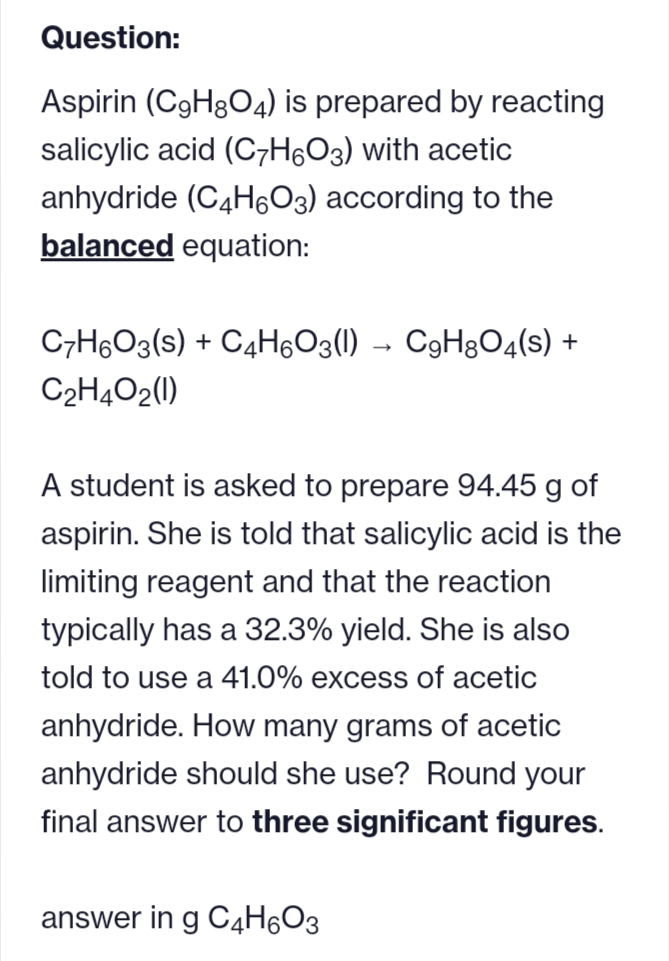C7H6O3(s) + C4H6O3(l) → C9H8O4(s) + C2H4O2(1) A student is asked to prepare 94.45 g of aspirin. She is told that salicylic acid is the limiting reagent and that the reaction typically has a 32.3% yield. She is also told to use a 41.0% excess of acetic anhydride. How many grams of acetic anhydride should she use? Round your final answer to three significant figures.
C7H6O3(s) + C4H6O3(l) → C9H8O4(s) + C2H4O2(1) A student is asked to prepare 94.45 g of aspirin. She is told that salicylic acid is the limiting reagent and that the reaction typically has a 32.3% yield. She is also told to use a 41.0% excess of acetic anhydride. How many grams of acetic anhydride should she use? Round your final answer to three significant figures.
Introduction to General, Organic and Biochemistry
11th Edition
ISBN:9781285869759
Author:Frederick A. Bettelheim, William H. Brown, Mary K. Campbell, Shawn O. Farrell, Omar Torres
Publisher:Frederick A. Bettelheim, William H. Brown, Mary K. Campbell, Shawn O. Farrell, Omar Torres
Chapter4: Chemical Reactions
Section: Chapter Questions
Problem 4.64P: 4-64 Aspirin is made by the reaction of salicylic acid with acetic anhydride. How many grams of...
Related questions
Question

Transcribed Image Text:Question:
Aspirin (C9H8O4) is prepared by reacting
salicylic acid (C7H6O3) with acetic
anhydride (C4H6O3) according to the
balanced equation:
C7H6O3(s) + C4H₁O3(l) → CH8O4(s) +
C₂H4O2(1)
A student is asked to prepare 94.45 g of
aspirin. She is told that salicylic acid is the
limiting reagent and that the reaction
typically has a 32.3% yield. She is also
told to use a 41.0% excess of acetic
anhydride. How many grams of acetic
anhydride should she use? Round your
final answer to three significant figures.
answer in g C4H6O3
Expert Solution
This question has been solved!
Explore an expertly crafted, step-by-step solution for a thorough understanding of key concepts.
Step by step
Solved in 2 steps with 2 images

Knowledge Booster
Learn more about
Need a deep-dive on the concept behind this application? Look no further. Learn more about this topic, chemistry and related others by exploring similar questions and additional content below.Recommended textbooks for you

Introduction to General, Organic and Biochemistry
Chemistry
ISBN:
9781285869759
Author:
Frederick A. Bettelheim, William H. Brown, Mary K. Campbell, Shawn O. Farrell, Omar Torres
Publisher:
Cengage Learning

Chemistry & Chemical Reactivity
Chemistry
ISBN:
9781337399074
Author:
John C. Kotz, Paul M. Treichel, John Townsend, David Treichel
Publisher:
Cengage Learning

Chemistry & Chemical Reactivity
Chemistry
ISBN:
9781133949640
Author:
John C. Kotz, Paul M. Treichel, John Townsend, David Treichel
Publisher:
Cengage Learning

Introduction to General, Organic and Biochemistry
Chemistry
ISBN:
9781285869759
Author:
Frederick A. Bettelheim, William H. Brown, Mary K. Campbell, Shawn O. Farrell, Omar Torres
Publisher:
Cengage Learning

Chemistry & Chemical Reactivity
Chemistry
ISBN:
9781337399074
Author:
John C. Kotz, Paul M. Treichel, John Townsend, David Treichel
Publisher:
Cengage Learning

Chemistry & Chemical Reactivity
Chemistry
ISBN:
9781133949640
Author:
John C. Kotz, Paul M. Treichel, John Townsend, David Treichel
Publisher:
Cengage Learning